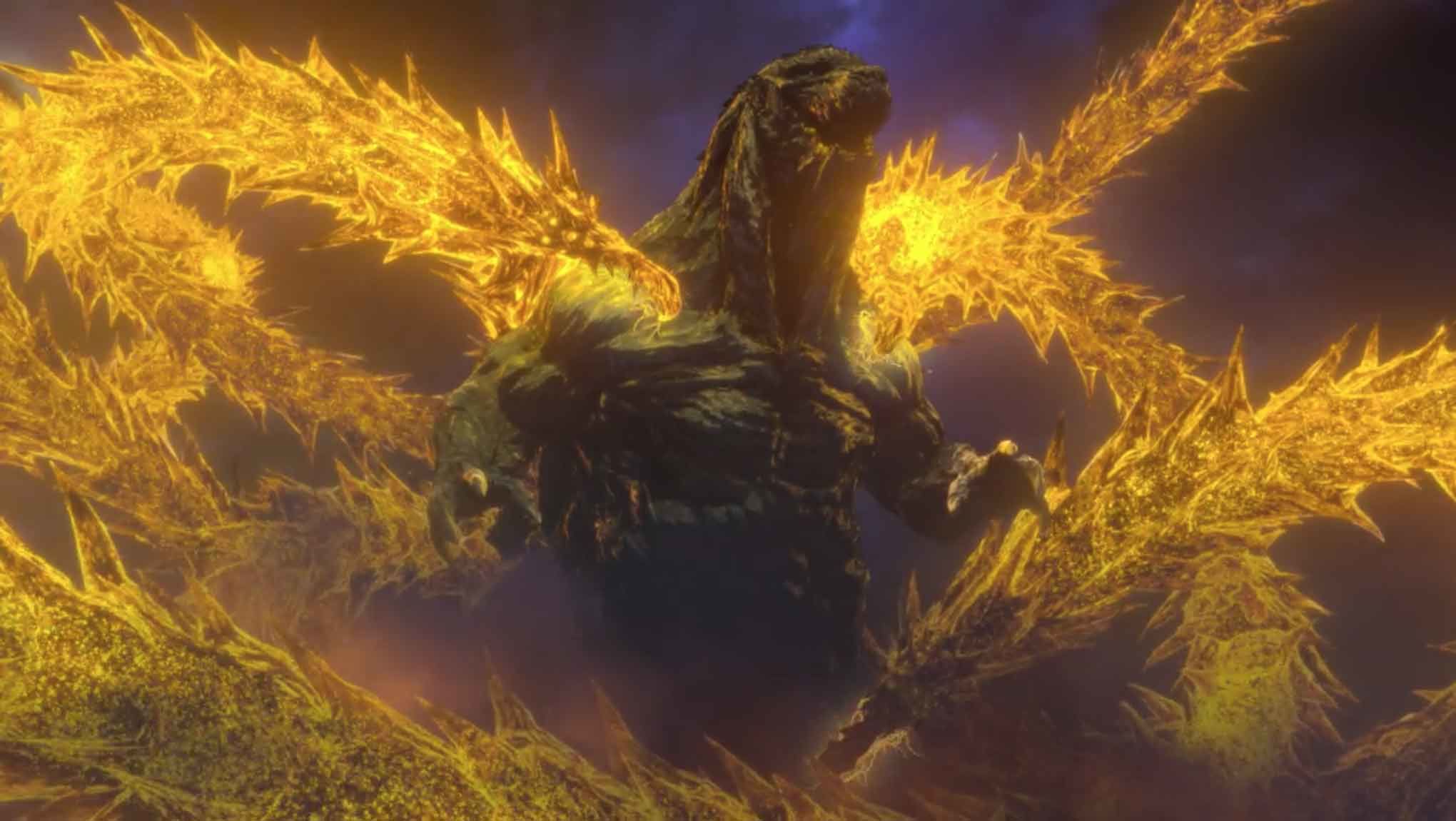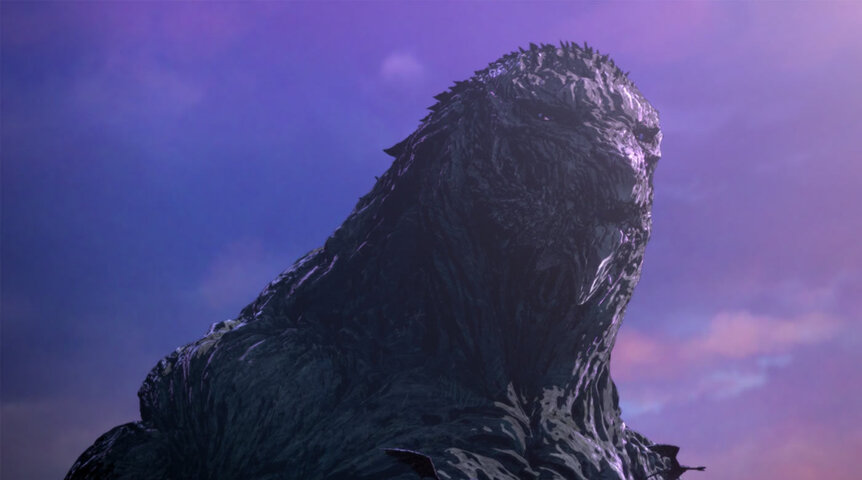Netflix's Godzilla: The Planet Eater is the best of a misfire of a series

The Toho Godzilla series has gone through a number of ups and downs in the course of its now 65-year history. Having changed creative hands (both on and off the set) many times in those six and a half decades — not to mention being influenced by regularly evolving (or devolving) economic circumstances — the output of movies featuring the King of the Monsters presents a broad qualitative spectrum, from visionary classics to solidly entertaining efforts to the occasional disheartening dud. (To like a franchise is not necessarily to like everything said franchise produces, and with 34 films released to date — including two Hollywood entries — obviously not every single swing resulted in a home run.)
In regards to past failings in the Godzilla series, one could always expect to find, at the very least, a couple of redeeming features — not enough to save the entire project but worthy of acknowledgment all the same. The cheaply made Godzilla vs. Megalon (1973) was not my cup of tea, but the Ogouchi Dam sequence was a masterclass of great miniature work. I try my best not to think about the wretched Godzilla: Final Wars (2004), but the modernized Gigan design in that film scored a few positive points in my book.
Likewise, I don’t have tremendous enthusiasm for the post-1991 Heisei movies, but even the dimmest of those had some colorful effects and rousing music to fall back on. And at the risk of voicing blasphemy in the minds of fellow genre fans: as much as I didn’t care for 2016’s Shin Godzilla, there were a few witty moments of political satire and one spellbinding city destruction scene that remains vivid in my memory to this day. These are not films I have much admiration for, but there were aspects — if only aspects — to them that I could appreciate.
By comparison, I find myself gritting my teeth in saying anything even remotely nice about the recent Godzilla anime trilogy put out by Toho Animation and Polygon Pictures (streaming through Netflix). Having previously suffered through the insomnia-curing Godzilla: Planet of the Monsters (2017) and the absolute zero of a movie that was its sequel, Godzilla: City on the Edge of Battle (2018), my past compliments on this latest incarnation of the King of the Monsters can be counted on a single hand (with more than a few fingers to spare). And now, with the release of the third film, Godzilla: The Planet Eater, my domineering sentiment is mere reflection — and gratitude — that, at long last, this excruciating journey into mind-numbing pretension is done and over with. No follow-up of any kind could redeem the poor writing and execution of Parts 1 and 2, and even if such a thing were possible, Part 3 doesn’t even come close.
Now, to begin on a positive note, I am confident in labeling Godzilla: The Planet Eater the best of the three movies, for there are a few mildly effective things occurring within its dreary wastes of boredom (albeit mostly sequestered into little moments rather than expanded into full-on subplots). For one thing, returning screenwriter Gen Urobuchi picks up a few ideas from the last two movies and — gasp! — gives them some much-needed attention.
The tribe of humanoids from City on the Edge of Battle has a little more presence this time around: we actually receive little glimpses of them living with and interacting with the human characters — not simply introducing themselves and then standing around like a bunch of glittering statues (though there is a lot of that, too). Their god — this trilogy’s version of Mothra — actually appears, if only fleetingly, in the third act. An attempt is made to build a relationship between the main character of Haruo and the native girl who rescued him at the end of Planet of the Monsters (something which really should’ve been fleshed out in the second movie).
Another example. A promising subplot (or the start of one) appears early on, regarding a power struggle on the spaceship hovering just outside Earth’s atmosphere. One of the three races inhabiting the ship wishes to see Haruo executed for allowing MechaGodzilla City to be destroyed and, therefore, stages a coup, demanding the humans give in to their terms. A nice advancement from the plateau of blathering which infested similar scenes previously.
None of these scenes are satisfyingly developed, mind you. But compared to the last two films, which seemed perfectly content to drop all interesting ideas mere minutes after they appeared, this is a (somewhat) refreshing change of pace.
There’s more cerebral, psychedelic imagery this time around, and it is with great pleasure that I announce returning composer Takayuki Hattori has delivered a decent score for the trilogy’s conclusion. I was one of the three or four sentient beings in this solar system who absolutely adored Hattori’s music for Godzilla vs. SpaceGodzilla (1994) and Godzilla 2000: Millennium (1999), and I was utterly dismayed by the largely unmemorable tracks in his OSTs for Planet of the Monsters and City on the Edge of Battle. Granted, The Planet Eater’s score hardly represents Hattori at his best, but there are a couple of tracks here I can still hum from memory. He, too, has taken steps forward.
So there are little jabs of improvements on display in this new film. Unfortunately, that’s about it as far as positive qualities — and entertainment — go in discussing The Planet Eater. For the third entry in Godzilla’s animated trilogy suffocates under the exact same tonnage of flaws which made its predecessors unbearable.
It begins with the characters. With the very slight exception of Haruo, one of the native humanoid girls, and the philosophizing alien Metphies (this time quoting Arthur C. Clarke), the protagonists remain completely indistinguishable and, worse still, forgettable. No one emerges as a fleshed-out, believable person; and no two characters have an even remotely convincing dynamic (as mentioned before, the relationship between Haruo and the native girl is touched on but not expanded to a satisfying degree). And just like before, co-directors Hiroyuki Seshita and Kobun Shizuno allow scenes of jabbering about technology, religion, the definition of deities, what it means to be human, etc. to drag on for interminable periods of time (not an issue in principle, but crippling here because the people conversing about said subjects are so vapid and indistinguishable) and make the film feel ten times longer than it really is.
Similarly, the monster sequences come up short, yet another problem which has affected this trilogy from its inception. While Planet of the Monsters had one admittedly cool finishing scene in which Godzilla rose out of the ground and shot down his panicking enemies as they attempted to flee, City on the Edge of Battle offered nothing but monotony in its depiction of an all-out war between the characters and the monster (and between the characters themselves); and The Planet Eater exhibits no improvements.
The grand entrance of Godzilla’s opponent (the latest incarnation of King Ghidorah) is imaginatively conceived (the three-headed kaiju this time heralds from another dimension), but the actual battle consists primarily of Godzilla just standing inertly while the other monster’s three heads swirl around on chain-like necks and bite his arms and one of his legs — all presented in very static camera angles and offering very little cinematic movement. Even when judged on its own terms as an attempt at visual spectacle, the monster action is cataclysmically dull.
It’s been clear from the start that screenwriter Urobuchi had a number of topics and themes in mind in writing these three films, but his absolute failure to deliver interesting characters (alarming, as this is the same man who penned the wonderful Puella Magi Madoka Magica) negates whatever potential his ambitions might’ve realized with better execution.
It’s not the ideas (the willingness to try something different) but the actual handling of the ideas (the poor writing, the clumsy direction, the lead-footed pacing) which brings about its downfall. Godzilla: The Planet Eater has a few things going for it that its two predecessors lacked, but it nonetheless fails — just as they did — to rise above the wall of mediocrity which has rendered this three-film saga the single dullest stretch in the history of the Godzilla franchise to date.
The views and opinions expressed in this article are the author's, and do not necessarily reflect those of SYFY WIRE, SYFY, or NBC Universal.






























